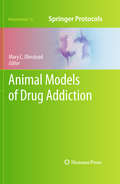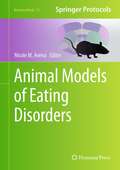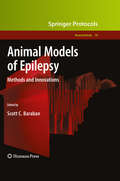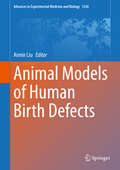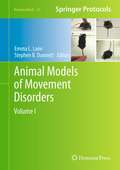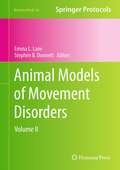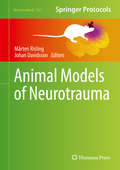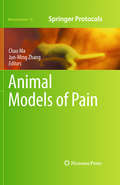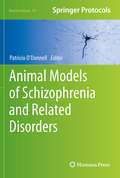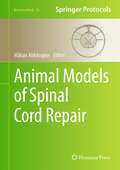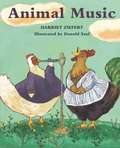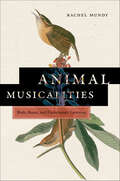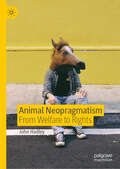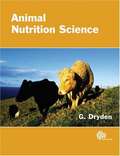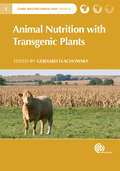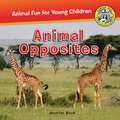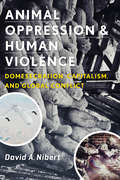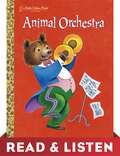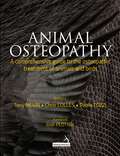- Table View
- List View
Animal Models of Drug Addiction (Neuromethods #53)
by Mary C. OlmsteadOur understanding of addiction and how it is treated has advanced remarkably over the past decades, and much of the progress is related directly to animal research. This is true for both the behavioural aspects of drug use as well as the biological underpinnings of the disorder. In Animal Models of Drug Addiction, experts in the field provide an up-to-date review of complex behavioural paradigms that model different stages of this disorder and explain how each test is used to effectively replicate the progression of drug addiction. This detailed and practical book begins with the most common laboratory measures of addiction in animals, including intracranial self-stimulation (ICSS), drug self-administration, place conditioning, and sensitization. Later chapters describe how these paradigms are used to model the progression of drug addiction, providing insight into the clinical symptomatology of addiction from acquisition of drug use through compulsive drug taking to withdrawal and relapse. Written for the popular Neuromethods series, the contributions offer both methodological detail and a theoretical perspective, appealing to readers familiar with preclinical research on drug addiction as well as those who are newcomers to the field. Cutting-edge and authoritative, Animal Models of Drug Addiction will serve as a basis for future vital research that links the bench to the bedside in the crucial treatment of drug addiction.
Animal Models of Eating Disorders (Neuromethods #74)
by Nicole M. AvenaThe growth of the field of eating disorder research has led to a vast array of empirical articles, and the development of new animal models that can be used to study these disorders continues to stimulate new research. Animal Models of Eating Disorders serves as a collection of detailed techniques contributed by experts in the field who are well-versed in the development and implementation of these models. Since eating disorders are complex and likely due to a combination of environmental, genetic, and social causes, the detailed chapters of this volume have been designed to highlight different contributing factors. Collectively, these chapters give a comprehensive and representative overview of both recently developed and classic methodologies used in the study of eating disorders. Written for the popular Neuromethods series, this work contains the kind of thorough description and implementation advice that promises successful results. Authoritative and practical, Animal Models of Eating Disorders aims to aid researchers in the use of animal models to assist in their investigation and characterization of the behaviors and neurochemical alterations associated with these devastating disorders.
Animal Models of Epilepsy: Methods and Innovations (Neuromethods #40)
by Scott C. BarabanWith its complex anatomical, molecular, electrophysiological and behavioral components, epilepsy provides the neuroscientist with nearly boundless opportunities to examine basic neurobiological mechanisms. In Animal Models of Epilepsy: Methods and Innovations, prominent investigators in the field examine several novel models of epilepsy in mice as well as in genetically tractable "simple" species such as Drosophila melanogaster (fruit flies), Caenorhabditis elegans (worms), Xenopus laevis (tadpoles) and Danio rerio (zebrafish). While covering some traditional models, the volume also explores the newest innovations like modeling seizure activity in silica and advanced strategies for seizure detection and gene therapy. As a volume in the successful NeuromethodsTM series, the chapters provide clear, step-by-step protocols and thought-provoking reviews of the most recent advancements in the field. Comprehensive and cutting-edge, Animal Models of Epilepsy: Methods and Innovations is an ideal guide for scientists who wish to expand our understanding of the pathogenesis of this neurological disorder.
Animal Models of Human Birth Defects (Advances in Experimental Medicine and Biology #1236)
by Aimin LiuThis book focuses on the use of animal models to study various human defects. It summarizes our current understanding of a variety of common human birth defects and the essential role of animal models in shedding light on the underlying mechanisms of these disorders. Birth defects are the leading cause of infant deaths, and cost billions of dollars in care for those affected. Unfortunately, the lack of a clear understanding of the mechanisms leading to many of these developmental disorders has hindered effective prevention and early intervention strategies. Studies using animal models have provided essential insights into several human birth defects. This book serves as a valuable reference resource for researchers and graduate students who are interested in learning the basic principles as well as the latest advances in the study of the mechanisms of human birth defects.
Animal Models of Movement Disorders, Volume I: Volume I (Neuromethods #61)
by Stephen B. Dunnett Emma L. LaneMovement is the way that animals interact with their environment and is under the organization and complex control of the brain and spinal cord. Multiple central nervous systems, including cortex, basal ganglia, cerebellum, and brainstem, interact to provide precise motor control and integration. Damage or disease within these systems cause profound motor disturbances in man, which can be effectively modeled in animals to develop a better understanding and treatment of the human condition. Animal Models of Movement Disorders introduces a variety of methods and techniques used to model and assess motor function in experimental animals from lower orders, such as drosophila and c. elegans, through vertebrate species including fish, to mammals, such as rodents and non-human primates. The most advanced contemporary models in each system are presented at multiple levels of analysis from molecular and genetic modeling, lesions, anatomy, neurochemistry, to imaging and behavior. Volume I contains general methods of movement disorder assessment as well as an extensive section on dopamine systems. <P><P> Comprehensive and meticulous, Animal Models of Movement Disorders serves as a valuable reference for those studying motor disorders by covering methodologies in detail and providing the information necessary to consider both the appropriate models and assessment tools that can most informatively answer the key experimental issues in the field.
Animal Models of Movement Disorders, Volume II: Volume II (Neuromethods #62)
by Stephen B. Dunnett Emma L. LaneMovement is the way that animals interact with their environment and is under the organization and complex control of the brain and spinal cord. Multiple central nervous systems, including cortex, basal ganglia, cerebellum, and brainstem, interact to provide precise motor control and integration. Damage or disease within these systems cause profound motor disturbances in man, which can be effectively modeled in animals to develop a better understanding and treatment of the human condition. Animal Models of Movement Disorders introduces a variety of methods and techniques used to model and assess motor function in experimental animals from lower orders, such as drosophila and c. elegans, through vertebrate species including fish, to mammals, such as rodents and non-human primates. The most advanced contemporary models in each system are presented at multiple levels of analysis from molecular and genetic modeling, lesions, anatomy, neurochemistry, to imaging and behavior. Volume II of this detailed collection contains sections on the basal ganglia, neo- and allo-cortical systems, cerebellar and brain stem systems, as well as spinal cord systems.<P><P> Comprehensive and meticulous, Animal Models of Movement Disorders serves as a valuable reference for those studying motor disorders by covering methodologies in detail and providing the information necessary to consider both the appropriate models and assessment tools that can most informatively answer the key experimental issues in the field.
Animal Models of Neurotrauma (Neuromethods #149)
by Mårten Risling Johan DavidssonThis volume looks into the need for a variety of experimental models for research on traumatic brain injury (TBI) and peripheral nervous system. It also describes a number of experimental models, such as mechanical devices, that have been developed to model neurotrauma in animal experiments. The overall aim of this book is to explore the variety of models and how they are used in current research. The chapters in this book are organized in four sections and talk about animal models for TBI; animal models for spinal cord or nerve injury; and translational aspects, secondary injuries, in vitro studies, and evaluation of large data sets. In Neuromethods series style, chapters include the kind of detail and key advice from the specialists needed to get successful results in your laboratory.Cutting-edge and comprehensive, Animal Models of Neurotrauma is a valuable resource for researchers interested in expanding their knowledge and research in this developing field.
Animal Models of Pain (Neuromethods #49)
by Jun-Ming Zhang Chao MaWith the loss of work days, the price of health care and payments for compensation, litigation, and malpractice, and the overwhelming cost of human suffering, chronic pain syndromes affect humanity enormously on both an economic and personal level. In Animal Models of Pain, expert investigators in the field provide a consolidated review of the current state of pain research by capturing the diversity of animal models that are used to investigate pain mechanisms, which range from surgical incision to mechanical compression and from spinal cord injury to cutaneous/local inflammation and beyond. As a volume in the respected Neuromethods series, this book delivers its vital content through detailed descriptions of a wide variety of step-by-step laboratory methods. Authoritative and cutting-edge, Animal Models of Pain seeks to lead scientists closer to the ultimate goal of improving the quality of life and relieving the unbearable burden of chronic pain for millions of people throughout the world.
Animal Models of Schizophrenia and Related Disorders (Neuromethods #59)
by Patricio O'DonnellAnimal models of schizophrenia and other major psychiatric disorders have been sought for decades, and, as a result, we are now facing new vistas on pathophysiology that could lead to novel therapeutic approaches and even hint at possible preventive strategies. Animal Models of Schizophrenia and Related Disorders presents an overview of the information that can be obtained with several different models and a detailed account of how to generate such models in order to ensure that the manipulations used to model schizophrenia-relevant phenomena are used consistently across laboratories. This detailed volume features pharmacological models such as non-competing NMDA antagonists, emphasizing their use in vitro, neurodevelopmental models such as the neonatal ventral hippocampal lesion and the antimitotic MAM, models that reproduce environmental factors such as neonatal hypoxia, vitamin D deficits, and prenatal immune activation, as well as several different genetic model approaches. As a volume in the Neuromethods series, this volume contains the kind of detailed description and implementation advice that is crucial for getting optimal results. Practical and cutting-edge, Animal Models of Schizophrenia and Related Disorders highlights the successes in the use of animal models to gain insight on pathophysiological mechanisms of relevance to major psychiatric disorders in the hope of inspiring investigators to expand the research and test targets that could restore or ameliorate function.
Animal Models of Spinal Cord Repair (Neuromethods #76)
by Håkan AldskogiusThe development of treatment strategies that can help patients with spinal cord injury to regain lost functions and an improved quality of life is a major medical challenge, and experimental spinal cord research has to meet these challenges by resolving fundamental problems, establishing a basis for possible novel treatment strategies of spinal cord injury, and motivating their clinical translation. In Animal Models of Spinal Cord Repair, expert researchers examine a broad range of experimental models for research on spinal cord injury, how they have contributed to our current state of knowledge, and what their advantages are in the further advancement of spinal cord repair. With models from simple lamprey to non-human primates, the information presented is intended to guide the implementation of animal models for spinal cord repair as well as to raise the awareness of the relevance of experimental models which may not be in the current mainstream of this research. As a part of the Neuromethods series, this work contains the kind of detailed description and implementation advice to guarantee successful results in the laboratory. Comprehensive and cutting-edge, Animal Models of Spinal Cord Repair presents the background information and hands-on methods descriptions, as well as the basic and clinical issues, needed to stimulate and guide researchers with different backgrounds towards the development of improved strategies for functionally relevant repair of the injured human spinal cord.
Animal Monsters: The Truth About Scary Creatures
by Laurence PringleDragons, giants, sea serpents--these are the monsters of yesteryear, but they lived only in the imagination. People today still like to create monsters, but everyone knows they aren't real. Or are they? There are scary creatures in the world that may seem like monsters, and they can be very dangerous. But many "monsters" are less exciting and harmful than people would believe. The truth about these creatures-and some that live only in the human imagination--is in this book!
Animal Movement: Statistical Models for Telemetry Data
by Juan M. Morales Mevin B. Hooten Devin S. Johnson Brett T. McClintockThe study of animal movement has always been a key element in ecological science, because it is inherently linked to critical processes that scale from individuals to populations and communities to ecosystems. Rapid improvements in biotelemetry data collection and processing technology have given rise to a variety of statistical methods for characterizing animal movement. The book serves as a comprehensive reference for the types of statistical models used to study individual-based animal movement. Animal Movement is an essential reference for wildlife biologists, quantitative ecologists, and statisticians who seek a deeper understanding of modern animal movement models. A wide variety of modeling approaches are reconciled in the book using a consistent notation. Models are organized into groups based on how they treat the underlying spatio-temporal process of movement. Connections among approaches are highlighted to allow the reader to form a broader view of animal movement analysis and its associations with traditional spatial and temporal statistical modeling. After an initial overview examining the role that animal movement plays in ecology, a primer on spatial and temporal statistics provides a solid foundation for the remainder of the book. Each subsequent chapter outlines a fundamental type of statistical model utilized in the contemporary analysis of telemetry data for animal movement inference. Descriptions begin with basic traditional forms and sequentially build up to general classes of models in each category. Important background and technical details for each class of model are provided, including spatial point process models, discrete-time dynamic models, and continuous-time stochastic process models. The book also covers the essential elements for how to accommodate multiple sources of uncertainty, such as location error and latent behavior states. In addition to thorough descriptions of animal movement models, differences and connections are also emphasized to provide a broader perspective of approaches.
Animal Music
by Harriet ZiefertAn assortment of animals playing various instruments make different kinds of music.
Animal Musicalities: Birds, Beasts, and Evolutionary Listening (Music-culture Ser.)
by Rachel MundyOver the past century and a half, the voices and bodies of animals have been used by scientists and music experts as a benchmark for measures of natural difference. Animal Musicalities traces music's taxonomies from Darwin to digital bird guides to show how animal song has become the starting point for enduring evaluations of species, races, and cultures. By examining the influential efforts made by a small group of men and women to define human diversity in relation to animal voices, this book raises profound questions about the creation of modern human identity, and the foundations of modern humanism.
Animal Neopragmatism: From Welfare to Rights
by John HadleyThis book affords a neopragmatic theory of animal ethics, taking its lead from American Pragmatism to place language at the centre of philosophical analysis. Following a method traceable to Dewey, Wittgenstein and Rorty, Hadley argues that many enduring puzzles about human interactions with animals can be ‘dissolved’ by understanding why people use terms like dignity, respect, naturalness, and inherent value. Hadley shifts the debate about animal welfare and rights from its current focus upon contentious claims about value and animal mindedness, to the vocabulary people use to express their concern for the suffering and lives of animals. With its emphasis on public concern for animals, animal neopragmatism is a uniquely progressive and democratic theory of animal ethics.
Animal Nutrition Science
by Gordon DrydenWritten for senior undergraduate and graduate students, Animal Nutrition Science introduces the fundamental topics of animal nutrition, in a treatment which deals with terrestrial animals in general. Addressing a wider range of topics than the standard animal nutrition texts, the subjects covered include nutritional ecology and the evolution of feeding styles, nutrients (including minerals, vitamins and water) and their functions, food composition and methods of evaluating foods, mammalian and microbial digestion and the supply of nutrients, control and prediction of food intake, quantitative nutrition and ration formulation, methods of investigating nutritional problems, nutritional genomics, nutrition and the environment, and methods of feed processing and animal responses to processed foods. The many references provide the scientific basis for the text, and give signposts for the reader to extend their enquiry in topics of interest.
Animal Nutrition with Transgenic Plants
by Tj Higgins Jie Wen Klaus Ammann Gerhard Flachowsky Yi Liu Ralf Einspanier Matin Qaim Atte Von Wright Agnes Ricroch Thomas Frenzel Marc De Loose Joachim Scholderer Emilio Rodriguez-Cerezo* Gathers together more than 150 feeding studies with food-producing animals and covers both first and second generation transgenic plants * The first central resource of this information for researchers, students and policy makers * Includes contributions from a wide range of specialists in the field
Animal Nutrition with Transgenic Plants (CABI Biotechnology Series #1)
by Tj Higgins Jie Wen Klaus Ammann Yi Liu Ralf Einspanier Matin Qaim Atte Von Wright Agnes Ricroch Thomas Frenzel Marc De Loose Joachim Scholderer Emilio Rodriguez-Cerezo* Gathers together more than 150 feeding studies with food-producing animals and covers both first and second generation transgenic plants * The first central resource of this information for researchers, students and policy makers * Includes contributions from a wide range of specialists in the field
Animal Offspring: Elephants and Their Calves
by Margaret HallThe Animal Offspring series supports national science standards related to life science. This book describes and illustrates elephants and their calves.
Animal Opposites (Ranger Rick: Animal Fun for Young Children)
by Jennifer BovéWith adorable full-color photographs throughout and simple activities to be enjoyed with Mom or Dad&’s guidance, Ranger Rick Jr. books are perfect for young children starting to learn about the world around them. These small books are a great way to start your child&’s first library! Animal Opposites explores the opposing ways animals live, eat, hunt, and play! Through full color photographs and illustrations, and educational, entertaining text, this book shows that just how different animals can be!
Animal Oppression and Human Violence: Domesecration, Capitalism, and Global Conflict (Critical Perspectives on Animals: Theory, Culture, Science, and Law)
by David NibertJared Diamond and other leading scholars have argued that the domestication of animals for food, labor, and tools of war has advanced the development of human society. But by comparing practices of animal exploitation for food and resources in different societies over time, David A. Nibert reaches a strikingly different conclusion. He finds in the domestication of animals, which he renames "domesecration," a perversion of human ethics, the development of large-scale acts of violence, disastrous patterns of destruction, and growth-curbing epidemics of infectious disease. <P><P>Nibert centers his study on nomadic pastoralism and the development of commercial ranching, a practice that has been largely controlled by elite groups and expanded with the rise of capitalism. Beginning with the pastoral societies of the Eurasian steppe and continuing through to the exportation of Western, meat-centered eating habits throughout today's world, Nibert connects the domesecration of animals to violence, invasion, extermination, displacement, enslavement, repression, pandemic chronic disease, and hunger. In his view, conquest and subjugation were the results of the need to appropriate land and water to maintain large groups of animals, and the gross amassing of military power has its roots in the economic benefits of the exploitation, exchange, and sale of animals. Deadly zoonotic diseases, Nibert shows, have accompanied violent developments throughout history, laying waste to whole cities, societies, and civilizations. His most powerful insight situates the domesecration of animals as a precondition for the oppression of human populations, particularly indigenous peoples, an injustice impossible to rectify while the material interests of the elite are inextricably linked to the exploitation of animals. Nibert links domesecration to some of the most critical issues facing the world today, including the depletion of fresh water, topsoil, and oil reserves; global warming; and world hunger, and he reviews the U.S. government's military response to the inevitable crises of an overheated, hungry, resource-depleted world. Most animal-advocacy campaigns reinforce current oppressive practices, Nibert argues. Instead, he suggests reforms that challenge the legitimacy of both domesecration and capitalism.
Animal Orchestra (Little Golden Book)
by Ilo OrleansIn this Read & Listen edition of the classic Little Golden Book from 1958, an animal orchestra and its hippo conductor put on a performance for a happy crowd of their animal friends. Children will have front-row seats as they imagine the rousing experience of hearing an orchestra!This ebook includes Read & Listen audio narration.
Animal Osteopathy: A comprehensive guide to the osteopathic treatment of animals and birds
by Christopher Colles Anthony Nevin Paolo TozziThis is a comprehensive reference textbook for all those using osteopathic treatment techniques with animals or birds or studying to do so. The book is divided into sections: equine osteopathy; general small animal osteopathy; osteopathy for exotics- (pets such as tortoise, snakes, ferrets etc); osteopathy for wildlife - native as well as non to the UK including species found in most zoological collections; avian osteopathy - both domestic and wild/exotic. Each section covers information specific to that group. This makes the book appropriate for supporting structured post-graduate university validated courses in a clear and easily navigable way.Content includes detailed sections on the differences encountered when working with animals; health and safety around different species; working within the law; integrating with allied professions; anatomy; physiology and patho-physiology; neurology; orthopaedics; differential diagnosis; differential aetiology of presenting conditions when compared to the human model; supportive husbandry and rehabilitation methods.It includes sections covering approaches to patient care; specifics of taking a detailed case history; use of supporting diagnostics; observation; palpation; structuring a treatment programme suitable for each species. Osteopathic treatment techniques and physical patient contact methods are be explained as well as graphically illustrated. All chapters are fully referenced and include revision notes to act as guidelines for the reader.It is intended primarily for post-graduate osteopaths intending to work with animals or who are already doing so. It will also strongly appeal to vets as well as to other allied professions working with animals (eg massage therapists).
